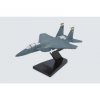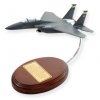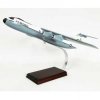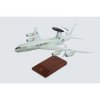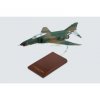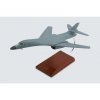"The F-15E Strike Eagle is a dual-role fighter designed for long range interdiction of enemy ground targets deep behind enemy lines. An array of avionics and electronics systems gives the aircraft the capability to fly at low altitude, day or night, and in any weather condition. Derived from the F-15 Eagle, the Strike Eagle has proved its worth in various operations, carrying out deep strikes against high value targets and providing close air support for coalition troops. The F-15E can be distinguished from the F-15 by its darker camouflage and the conformal fuel tanks attached to the fuselage. In March 1981, the United States Air Force (USAF) announced the Enhanced Tactical Fighter program to procure a replacement for the F-111 Aardvark. General Dynamics and McDonnell Douglas submitted proposals, and in February 1984, the contract was awarded to McDonnell Douglas. The F-15E had its maiden flight on December 11, 1986. While designed for ground attack, the versatile Strike Eagle retains much of the air-to-air lethality of the F-15 and can defend itself against enemy aircraft. The F-15E saw combat during Operations Desert Shield and Desert Storm after Iraq invaded Kuwait in August 1990. On February 14, 1991, an F-15E scored an air-to-air kill, a Mil Mi-24 Hind helicopter. The attack was in response to a request for help by US Special Forces. Following Desert Storm, two no-fly zones were set up over Iraq and policed mainly by US and UK aircraft. The Strike Eagle would fly into combat on many occasions over the next decade and was the most highly-tasked of all USAF tactical fighters. The F-15E usually attacked ammunition bunkers, command and control facilities, towed anti-aircraft batteries and launchers. It also cooperated with other aircraft in strikes. "
Scale: 1/42 scale model
Wing Span: 12.25
Length: 18.25
CF015ETS
|
"The F-15E Strike Eagle, manufactured by McDonnell Douglas / Boeing IDS, is a modern United States all-weather strike fighter, designed for long-range interdiction of enemy ground targets deep behind enemy lines. On December 11, 1986, the F-15E had its first flight. The F-15E became the newest fighter in Tactical Air Command when the 405th Tactical Training Wing, Luke Air Force Base, Ariz., accepted delivery of the first production model in April 1988. The 4th Fighter Wing at Seymour Johnson Air Force Base, N.C., was the first operational F-15E Strike Eagle wing in the Air Force. A derivative of the F-15 Eagle air superiority fighter, the Strike Eagle proved its worth in Desert Storm, carrying out deep strikes against high-value targets and providing close air support for coalition troops. The F-15E Strike Eagle can be distinguished from the F-15 Eagle by its darker camouflage and the presence of the conformal fuel tanks attached to the aircraft's fuselage. This new version was designed to penetrate deep into enemy territory unescorted, and strike military targets with pinpoint accuracy. The strike eagle employs two highly reliable Pratt & Whitney F100-PW-229 engines and was designed specifically as a two-person crew of pilot and weapons system officer. The LANTRIN (Low Altitude Navigation and Targeting Infra-Red for Night) system enables the Strike Eagle to operate at night and in bad weather. The Strike Eagle can also be employed with up to an 11-ton payload and can carry the GBU-28 Bunker Buster, a guided bomb developed to destroy strengthened underground bunkers. The Strike Eagle was first deployed in December 1989. During the Gulf War in 1991, 2 squadrons of 48 F-15E Strike Eagles demonstrated their power as multi-purpose fighter/attack planes. "
Scale: 1/72 scale model
Wing Span: 7.5
Length: 13
CF015ETR
|
"The F-15E Strike Eagle is a strike fighter, designed for long range interdiction of enemy ground targets deep behind enemy lies. The F-15E carried our deep strikes against high value targets and provided close air support for coalition troops. The F-15E is different from the F-15 in a way that the F-15 Eagle has darker camouflage and the presence of the conformal fuel tanks attached to the aircraft’s fuselage. The F-15E Strike Eagle used two crew members, a pilot and a weapon systems officer. Previous models of F-15E are assigned to air to air roles. The Strike Eagle’s way to fight it is to a target over long ranges, destroy enemy ground positions and fight its way out. The navigation system of Strike Eagle used a laser gyro and a Global Positioning System to monitor the aircrafts position as well as to provide information. APG-70 radar system detects ground targets for long ranges. Another feature of the system of F-15E Strike Eagle is that after a sweep of a target area, the crew freezes the air ground to clear air threats. Thus, the pilot is capable of detecting, targeting and engaging air to air targets. The rear cockpit and the weapons systems are the most important additions to the F-15E. The officer of Strike Eagle has four screens where in formation can be display from the radar, electronic warfare or infrared sensors, monitor aircraft or weapons status and possible threats, select targets and use an electronic to find the way. To select new displays, the f-15E has two hand controls. Displays can be moved from one screen to another. On April 1988, the first production of F-15E was delivered to the 405th Tactical Training Wing, Luke AFB, Ariz. The Strike Eagle was the first US operational aircraft whose engines’ thrust exceeded the plane’s loaded weight. Thus, permitting it to accelerate even in a vertical climb. "
LENGTH 8.5 INCHES
WINGSPAN 5.375 INCHES
|
"The F15A Eagle sometimes called “YF-15A”. There were 384 F15As that were built in history including 18 full scale development aircrafts. The serial number of the first produced F-15A was 71-0280 and it was used in the ceremony in St. Louis way back June 26, 1972. The F15A made its first flight on July 27, 1972 by company test pilot Irving Burrows. On March 1973, there was a production of thirty F15A and B aircrafts. The first F15, TF-15A 73-0108 was for an operational USAF unit. The said F15 was a replacement training unit for F15 operations during the first stage of the introduction of the Eagle into service. Winter of year 1974 to 1975, McDonnell altered the F-15A serial number 72-0119 to set the world time in order for him to climb records. The said project was called Streak Eagle. To rid of some weight for this project, all non important systems were deleted including the flap, speed brake, armament, radar and fire control system. The paint of the F15A was also ripped of, resulting a bare metal aircraft. The F-15A was 1800 pound less than the others. This F15A which was produced by the Streak Eagle project is now on outdoor display at the USAF Museum inside the Wright Patterson AFB in Dayton, Ohio. The F15A’s that were received by the USAF were used for testing. The testing of F15A went smoothly though there were structural changes including a notched stabilator and rake wingtips for production aircraft. The USAF ordered more 350 F15A models for their operational service. The F15A models were also used by Israel, Japan and Saudi Arabia. "
Scale: 1/48 scale model
Wing Span: 11.25
Length: 16
CF015T
|
"The Boeing C-17 Globemaster III is the newest, most flexible airlift aircraft to enter the United States and Western Air Forces. This aircraft is designed to fulfill airlift needs well into the next century - carrying large combat equipment and troops or humanitarian aid across international distances directly to small austere airfields anywhere in the world. The C-17 is also able to perform theater airlift and airdrop missions when required. The C-17 takes its name from two previous heavy lifter aircraft, the C-74 Globemaster and the C-124 Globemaster II. In January 1995, the Air Force declared the first C-17 squadron operational. Since then the fleet has amassed more than 200,000 flying hours. In May 1995, the C-17 received the prestigious Collier Trophy, symbolizing the top aeronautical achievement of 1994. In 1998, eight C-17s completed the longest airdrop mission in history, flying more than 8,000 nautical miles from the United States to Central Asia, dropping troops and equipment after more than 19 hours in the air. In February 1999, President Bill Clinton presented the Malcolm Baldrige National Quality Award for business excellence to Boeing Airlift and Tanker Programs, maker of the C-17. During normal testing, C-17s set 22 world records, including payload to altitude time-to-climb and the short takeoff and landing mark, in which the C-17 took off in less than 1,400 feet, carried a payload of 44,000 pounds to altitude, and landed in less than 1,400 feet. "
Scale: 1/164 scale model
Wing Span: 12.25
Length: 12.75
CC017T
|
"The C-21A is a military variant of the Learjet 35A business jet. It is a twin turbofan engine aircraft for cargo and passenger airlift and is also capable of transporting litters during medical evacuations. In April 1984, the delivery of the C-21A fleet began and was completed in October 1985 for deployment. On April 1, 1997, all continental US-based C-21s were realigned under Air Mobility Command, with the 375th Airlift Wing at Scott Air Force Base, Ill. as the lead command. C-21s stationed outside the continental United States are assigned to theater commanders. The C-21A has a maximum speed of 530 mph and a maximum range of 2,306 miles. It has a crew of two, a pilot and a co-pilot. The C-21A has a capacity of carrying eight passengers. The aircraft is equipped with an automatic navigation system and four cathode ray tubes display for enhanced pilot crew efficiency. There are 38 C-21As in active duty with the Air Force. "
Scale: 1/48 scale model
Wing Span: 9.5
Length: 12
CC021ATR
|
"The C-141 Starlifter, also known as “Hanoi Taxi”, was manufactured by Lockhead Corporation. This military strategic airlift aircraft was the world's first turbofan-powered transport and it served as a major component of the U.S. strategic airlift force since it entered operational service in 1965. The aircraft recorded more than 10.6 million operational hours in over four decades of service. In 2005, Hanoi Taxi was one of the aircraft marshaled by the Air Force to provide evacuation for those seeking refuge from Hurricane Katrina. This aircraft and others evacuated thousands of people, including the medical evacuation (MEDEVAC) of hundreds of ill & injured. At the end of its career as at the beginning, this aircraft brought Americans out of a hostile environment and back to safety. On May 6, 2006 at 9:30 AM, the Hanoi Taxi touched down for the last time and was received in a formal retirement ceremony at the National Museum of the United States Air Force, located at Wright Patterson Air Force Base (WPAFB) in Riverside, Ohio near Dayton. Hanoi Taxi is now part of the permanent static display collection of the Museum. "
Scale: 1/104 scale model
Wing Span: 19.25
Length: 20.25
CC141HT
Pre-Order! Available: 3rd Quarter, 2025
|
"After the inauguration of President John F. Kennedy, his first official act was the ordering of the development of an all-jet transport to extend the reach of US military forces. The new aircraft was to replace slower piston-engined cargo planes such as the Douglas C-124 Globemaster II. The Lockheed C-141 Starlifter was the result of this requirement. It served with the United States Air Force (USAF) as a military strategic airlifter and first flew in 1963. It was the first jet aircraft designed to meet military standards as a troop and cargo carrier. Operated by the Air Mobility Command (AMC) of the USAF, the C-141 can airlift and airdrop equipment, supplies and paratroops, whether at low or high altitudes. A total of 285 planes have been built, 284 for the Air Force and one for NASA. The Starlifter, which was designed to meet both military and civilian airworthiness standards, was the workhorse of the AMC. It fulfilled a vast array of requirements, including airlifting combat forces over long distances, re-supplying employed forces and providing rapid transfer of the sick and wounded from remote areas overseas to hospitals in the United States. The C-141 had an all-weather landing system, pressurized cabin and crew station. Rollers in the aircraft floor allowed quick and easy cargo pallet loading. When palletized cargo was not being carried, the rollers could be turned over to leave a smooth, flat surface for loading vehicles. Later on it was discovered that the Starlifter's volume capacity was relatively low in comparison to its lifting capacity, generally running out of physical space long before it reached its weight limit. To correct the deficiencies and utilize the aircraft to the fullest of its capabilities, 270 C-141As were stretched by about one third, adding needed payload volume. The new variant was designated C-141B. Increasing the aircraft's cargo capacity was the equivalent of buying 90 new planes. The C-141B also had in-flight refueling capability, which allowed longer non-stop flights and fewer fuel stops during worldwide airlift missions. "
Scale: 1/100 scale model
Wing Span: 19.25
Length: 20.25
CC141T
|
The USAF's C-27 Spartan is a twin turboprop engine aircraft modified from the G222 airframe manufactured in Naples, Italy, by Alenia, S.P.A. Chrysler Technologies Airborne Systems, Inc. and is modified by installing upgraded navigation, communication and mission systems required for C-27A operation.
Scale: 1/72 scale model
Wing Span: 15.75
Length: 11.5
CC27ST
|
"The C-32A is a specially configured version of the Boeing 757-200 intercontinental airliner, selected along with the C-37A to replace the aging fleet of VC-137 aircraft. Active-duty aircrews from the 1st Airlift Squadron, 89th Airlift Wing at Andrews Air Force Base, Md., fly the aircraft. The contract was awarded for the C-32A in August 1996. By using commercial off-the-shelf acquisition practices, a new record has been set from contract award to aircraft delivery – in less than two years. The C-32A is the first military aircraft ever to be acquired in this manner. The 89th Airlift Wing acquired the first of four aircrafts in 19 June 1998, and the second aircraft arrived in Andrews three days later. The remaining two C-32As arrived in November and December. The C-32A is configured for 45 passengers and 16 crews, and was designed for a 4,150 nautical mile mission, roughly the distance from Andrews to Frankfurt, Germany. The aircraft is also Stage III noise level compliant. Inside the C-32A, communications are paramount. The heads of the state and other decision-makers can conduct business anywhere around the world. The C-32 has state-of-the-art avionics equipment. The C-32A is far more fuel efficient and quieter than the 707-based C-137s they are replacing. Each engine of the C-32A has 40,000 pounds of thrust, compared to the VC-137 engine that delivers 14,000 pounds. Yet, the C-32A's high-bypass-ratio engines, combined with an advanced wing design, help make the plane one of the quietest, most fuel-efficient jetliners in the world."
Wing Span: 19
Length: 19
CC37T
|
"The C-40B was built for the U.S. Air Force as a military version of the Boeing 737-700 Boeing Business Jet. The aircraft was created to replace the aging fleet of the C-137 aircraft for U.S. combatant commanders and other government leaders. The Air Force awarded the medium lift contract in August 2000. The 89th Airlift Wing acquired its first C-40B aircraft in December 2002. The aircraft is based in Andrews Air Force Base, Maryland. The 15th Airlift Wing, Hickam AFB, Hawaii acquired its C-40B for U.S. Pacific Command in February 2003. The C-40B is created to be an ""office in the sky"" for senior military and government officials. The C-40Bs are equipped with the Connexion by Boeing system, providing secure in-flight broadband connectivity -- data/video transmit and receive capability -- to enhance communications, productivity and security. This gives U.S. military officials the ability to conduct business anywhere around the world by using on-board Internet and local area network connections, telephones, satellites, television monitors, facsimile and copy machines. The C-40B has a computer-based passenger data system."
Scale: 1/100 scale model
Wing Span: 14
Length: 13.25
CC40BTR
|
"The Boeing E-3 sentry is a military airborne warning and control system (AWACS) aircraft that provides all-weather surveillance, command, control and communications to the United States, United Kingdom, France, NATO and other air defense forces. The E-3 offers superior surveillance capabilities. The E-3 Sentry is a modified Boeing 707-320B Advanced Commercial Airframe. It is a militarized version of the Boeing 707-320B commercial jetliner airframe. The USAF E-3 fleet completed its largest upgrade which is the Block 30/35 Modification in 2001. The four enhancements were the Electronic Support Measures (ESM) for passive detection, Joint Tactical Information Distribution System (JTIDS) to provide secure, anti-jam communication, memory capability enhancement in the computer and Global Positoning System (GPS). E-3 Sentry aircraft were among the first to deploy during Operation Shield where they immediately established an around-the-clock radar screen to defend against Iraqi forces. In its strategic defense role, the E-3 provides the means to detect, identify, track and intercept airborne threats. The E-10 MC2A, based upon the Boeing 767-400ER airframe, was intended to replace the United States operated E-3 (along with the RC-135 and the E-8 Oint STARS), but budget cutbacks have clouded its future. Production ended in 1992 after 68 had been built. "
Scale: 1/100 scale model
Wing Span: 17.5
Length: 18.5
CE3AT
|
"The supersonic long-range all-weather F-4 Phantom II was designed for the United States Navy (USN) by McDonnell Douglas. It first entered service in 1960. During the Vietnam War, it was the primary air superiority fighter and a workhorse fighter-bomber for the US Air Force (USAF), Navy and Marine Corps. By 1963, it had been adopted by the USAF for the fighter-bomber role. When production ended in 1981, a total of 5,195 F-4s had been built, making it the most numerous American supersonic military aircraft. In 2000, over 1,000 units were in service with 11 nations worldwide. Innovations in the F-4 included an advanced pulse-doppler radar and extensive use of titanium in the airframe. It could carry up to 8,480 kg of weapons such as air-to-air and air-to-ground missiles, as well as unguided, guided and nuclear bombs. The F-4E is the leading Phantom model, with 1,389 planes built. It took its maiden flight on June 30, 1967. The F-4E had an additional fuselage fuel tank, leading-edge slats for increased maneuverability, an improved engine, and an internally mounted 20 mm multibarrel gun with an improved fire-control system. The slats, weapons and radar controls were optimized for dogfighting, thus improving the aircraft's air-to-air capabilities. In air combat, the F-4's greatest advantage was its thrust, which permitted a skilled pilot to engage and disengage from the fight at will. Due to its distinctive appearance and its widespread service with various militaries, the F-4 is one of the best known icons of the Cold War. It performed well in the Vietnam War and Arab-Israeli conflicts, with F-4 crews achieving 393 aerial victories and completing countless ground attack sorties. The Phantom II has the distinction of being the last US fighter to attain ace status in the 20th century. It has also set 16 world records, and was the only aircraft used by both the USAF Thunderbirds and the USN Blue Angels. "
Scale: 1/48 scale model
Wing Span: 10
Length: 16.5
CF004ACT
|
"The long range, multi-role B-1 Lancer began as a replacement for the B-52 Stratofortress in the 1960s. It carries the largest payload of both guided and unguided weapons in the United States Air Force (USAF) inventory. The supersonic strategic bomber can rapidly deliver large quantities of precision and non-prescision weapons against any adversary to any location at any time. Although officially nicknamed the “Lancer”, B-1 crews prefer to call it the “Bone”. The origins of this nickname seem to have come from an early newspaper article about the aircraft, wherein its name was phonetically spelled out as “B-ONE”. The B-1B production version first flew in October 1984 and has been in service with the USAF since 1986. It is an improved variant initiated in 1981 by the Reagan administration. Major changes included additional structure to increase payload by 74,000 pounds, an improved radar and a radar cross section reduction. The B-1B's blended wing/body configuration, variable-geometry wings and turbofan afterburning engines all contribute to its long range, maneuverability, high speed and survivability. Its offensive avionics system allows tracking, targeting and engaging moving vehicles as well as self-targeting and terrain-following modes. The final B-1B was delivered on May 2, 1988. The B-1B was first used in combat during Operation Desert Fox in Iraq in December 1998. In 1999, six aircraft were used in Operation Allied Force, delivering more than 20 percent of the total ordnance while flying less than 2 percent of the combat sorties. B-1Bs were also deployed in support of Operation Enduring Freedom, dropping almost 40 percent of the total tonnage during the first six months. All of this was accomplished while maintaining an impressive 79 percent mission capable rate. "
Scale: 1/100 scale model
Wing Span: 16
Length: 17.5
CB1TR
|
"The B-2 Spirit aircraft began as a black project identified as High Altitude Penetrating Bomber. Then it became the Advanced Technology Bomber, utilizing the code Senior Cejay. Afterwards, it became the B-2 Spirit. In 1980’s, 23 billion dollars were spent secretly for studies and advancement of the aircraft. In 1985, the aircraft became a low altitude bomber from a high altitude bomber, which they spent an extra cost for. The B-2 was in service in three operations. Its first appearance was in the Kosovo War in 1999. It first brought the satellite guided JDAM in operations. Because of that, it was used in Operation Enduring Freedom in Afghanistan and in Operation Iraqi Freedom. The B-2 is extremely computerized. And unlike those single seat fighter aircrafts, a crew can sleep inside a B-2, set his meals or use a toilet. The B-2 Spirit is a stealth heavy bomber and has the ability of organizing both nuclear and conventional armaments. It is privately operated by the United States Air Force. Its advancement was a highlight in the upgrading program of the United States Department of Defense. The B-2 aircrafts 2nd generation stealth technology was to assist the aircraft's penetration function to go on tremendous anti-aircraft protection. "
Scale: 1/100 scale model
Wing Span: 20.5
Length: 8
CB22TR
|


